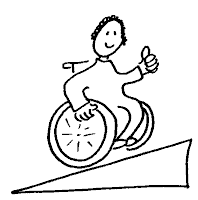WEBQUEST
Introduction: Everywhere you go there are wheelchair ramps that provide access for the handicapped. The American Disabilities Act requires that access ramps be provided in all public places. However is that ramp in your neighborhood legal?
Task: In order to complete this webquest students are required to calculate the slope of wheelchair ramps in the neighborhood by measuring the vertical distance (rise) and the horizontal distance (run). They must then decide whether this ramp is legal or not.
Process:
Required Materials:Two tape measures (25ft), Two meter sticks, Notepads, Minauture ramp model and Internet access.
Day One
Step 1- Have students sit in a wheelchair (if one is available) to experience what it is like to be handicapped, if possible have them go up various inclines in order to realize how difficult it is.
Step 2- Use ramp model to demonstrate how to measure the rise and run of the ramp model in the classroom and calculating the slope. Have students demonstrate their understanding by letting them measure the rise and run for various inclines of the ramp model.
Day Two
Step 3- Students will now proceed on a field trip around the neighborhood and identify ramps wheelchair ramps in public buildings. With permission they will measure the rise and run of these ramps and record their measurements.
Day Three
Step 4- Students will calculate the slope of the various ramps that they had measured the previous day using the slope formula (slope=rise/run). They will record the location and the corresponding slope of that ramp.
Step 5- Using the Internet to access the website http://www.access-board.gov/adaag/html/adaag.htm#A4.8.2 students will research the specific guidelines with regards to wheelchair access ramps.
Step 6- Based on the information gathered from the field trip and the online research, students will write a report of their findings and their conclusion as to whether the wheelchair ramps in the neighborhood are in legal compliance or not. The report must demonstrate an understanding of the law as well as empirical data to support the conclusion.
Extension- As an extension activity students could write to a local newspaper or to their local councilman to make him aware of any public buildings that are not in legal compliance with regards to wheelchair ramp accessibility.
Evaluation:
CATEGORY
Mathematical Concepts
4 Explanation shows complete understanding of the mathematical concepts used to solve the problem(s).
3 Explanation shows substantial understanding of the mathematical concepts used to solve the problem(s).
2 Explanation shows some understanding of the mathematical concepts needed to solve the problem(s).
1 Explanation shows very limited understanding of the underlying concepts needed to solve the problem(s) OR is not written
Mathematical Errors
4 90-100% of the steps and solutions have no mathematical errors.
3 Almost all (85-89%) of the steps and solutions have no mathematical errors.
2 Most (75-84%) of the steps and solutions have no mathematical errors.
1 More than 75% of the steps and solutions have mathematical errors.
Diagrams and Sketches
4 Diagrams and/or sketches are clear and greatly add to the reader's understanding of the procedure(s).
3 Diagrams and/or sketches are clear and easy to understand.
2 Diagrams and/or sketches are somewhat difficult to understand.
1 Diagrams and/or sketches are difficult to understand or are not used.
Strategy/Procedures
4 Typically, uses an efficient and effective strategy to solve the problem(s).
3 Typically, uses an effective strategy to solve the problem(s).
2 Sometimes uses an effective strategy to solve problems, but does not do it consistently.
1 Rarely uses an effective strategy to solve problems.
Explanation
4 Explanation is detailed and clear.
3 Explanation is clear.
2 Explanation is a little difficult to understand, but includes critical components.
1 Explanation is difficult to understand and is missing several components OR was not included.
Credits:
A Guide To ADA Wheelchair Ramps
http://www.a1-wheelchair-ramps.com/info/ada-wheelchair-ramps-html
Wheelchair Ramp Plans
http://wheelchairramponline.com/result.php?Keywords=Wheelchair%20Ramps
A Website Dedicated To Wheelchair Ramp Plans WheelchairRamp.SuperFastGuide.com
Wheelchair Ramp
http://www-wheelchairramps.info/result.php?Keywords=wheelchair%20ramps
A Website Dedicated To Wheelchair Ramp Wheelchair.InformationExpertise.com
Acknowledgement to Dibble High School, Dibble Oklahoma for the idea of this webquest.
http://www.scribd.com/doc/2241397/Slope-Lesson
Conclusion: This webquest answers the question; Is that slope legal? It gives students an appreciation of the application of mathematics in a real life situation and a greater understanding of the difficulties that handicap people face. Students should reflect on other activities that they can do to help the handicapped.
Teaching Guide:
· For this project students should be in small groups of 3-4.
· They should be grouped heterogeneously with each group having at least one Kinesthetic and Visual learner.
· Be sure to monitor students when they are doing research on the computer.
· When on the field trip be sure to get permission from building authorities before measuring the ramp to avoid any unpleasant situations.
· If students see anyone on a wheelchair, have them interview that person with regards to ramp access and include this in their report.
· This webquest is a modified version of an activity done by Dibble High School, Dibble Oklahoma, for a full version visit
http://www.scribd.com/doc/2241397/Slope-Lesson


